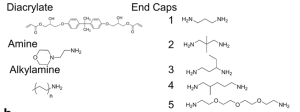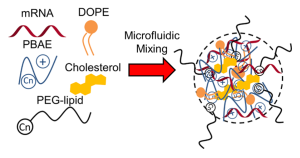41 Polymer Information
ajhodge2; mmdingle; and tmward2
Introduction
The technology discussed in Dr. Sadtler’s research revolves around the development of degradable poly(beta-amino ester) (PBAE) nanoparticles for mRNA delivery, particularly targeting the lungs. These nanoparticles are designed to address key challenges in mRNA therapeutics, such as ribonuclease-mediated degradation, cellular entry, and endosomal escape. By addressing these barriers, PBAE nanoparticles can enable precise and efficient delivery of mRNA to lung cells for various therapeutic purposes.
PBAEs are degradable polymers that are commonly used in drug delivery applications due to their ability to undergo hydrolysis, breaking down into their monomers. These smaller molecules are bio compatible and non-toxic, therefore they do not cause harm to cells or tissues. These polymers are relevant to mRNA delivery because they can encapsulate and protect mRNA molecules during systemic delivery, facilitate cellular uptake and promote endosomal escape. This process ensures that the mRNA can successfully create proteins in the targeted lung cells.
Chemical Structure
The chemical structure of the PBAE polymer involves the Michael addition reaction of an amine to a diacrylate under mild conditions. The monomers involved in this process include bisphenol A glycerolate (diacrylate) and 4-(2-amino methyl) morpholine (amine). This reaction forms a polymer backbone with ester linkages that can be broken down through hydrolysis. The backbone of the polymer contains alkylamine, which serves as a foundation for integrating hydrophobic moieties into nanoparticles.

This aspect is crucial for drug delivery because hydrophobic components allow for a more controlled release while improving encapsulation efficiency and enhancing the stability of the nanoparticles. Therefore, by incorporating hydrophobic moieties, the nanoparticles can better control the release of the drug, improving their overall effectiveness in drug delivery.

Physical and Chemical Properties
The physical and chemical properties of PBAEs further contribute to their suitability for mRNA delivery. Their degradability reduces potential toxicity, while their versatility in formulation allows for adjustment of nanoparticle characteristics. Additionally, the cationic charge of PBAEs facilitates efficient encapsulation of negatively charged mRNA molecules, enhancing their protection and delivery efficiency.
Selection and Benefits
The selection of PBAE polymers for mRNA delivery to the lungs is based on their ability to efficiently deliver nucleic acids while offering several advantages. PBAE polymers are chosen for their degradability, which allows them to undergo hydrolytic degradation, reducing the risk of toxicity associated with non-degradable polymers. Additionally, these polymers have been demonstrated to effectively target various lung cell types, including endothelial, epithelial, and immune cells. These properties make PBAEs potential applications for mRNA therapeutics in treating pulmonary diseases.
Media Attributions
- Figure 1
- Figure 2

